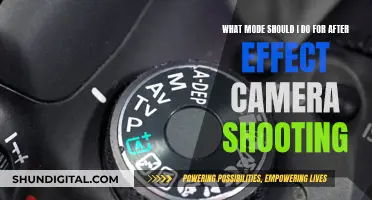
Focusing in photography is the process of making adjustments to the lens to find the maximum resolution, sharpness, and contrast for your chosen subject. This can be done either manually or with the autofocus system of your camera.
Manual focusing is typically done in genres where you have plenty of time, while autofocus is useful for quick focus. Autofocus is also usually preferred for unpredictable subjects that move so quickly that it's impossible to track them manually.
When using autofocus, you can choose from different autofocus modes, including:
- Single AF: ideal for posed portraits and landscapes.
- Continuous AF: better if your subject is going to be moving.
- Autofocus Hybrid: useful if your subject is unpredictable and can be static or moving.
When using manual focus, you can use the following techniques to find the optimum focus distance:
- Hyperfocal-distance shortcut: double the distance from the closest object and focus at that distance.
- Quick-and-dirty method: focus on the closest object, then the farthest object, then rock the focusing ring about halfway between those two distances.
| Characteristics | Values |
|---|---|
| Focus Mode | Single Shot Focus Mode, Continuous Focus Mode, Auto Focus Mode, Manual Focus |
| Focus Point Mode | Single Point, Zone/Multi, Auto |
| Drive Mode | Single Shot, Continuous Low, Continuous High |
| Aperture Setting | Large Aperture, Small Aperture |
| Focus Area | Area with Contrast, Eyes of a Person |
| Focus Technique | Hyperfocal-Distance Shortcut, Quick-and-Dirty Method |
What You'll Learn

Understand the different types of focus modes
Manual Focus Mode (M)
Manual focus mode is the oldest form of focusing, dating back to before autofocus technology was introduced in the 1980s. It gives you complete control over the focus and is still preferred by many professional photographers. You can adjust the lens ring to determine the focus distance. This mode is ideal for macro photography, product photos, and astrophotography, as it allows you to pinpoint the focus precisely. Additionally, it is more reliable in low-light conditions and can help avoid issues like focus shift.
Autofocus Mode (AF)
Autofocus mode utilises internal lens motors and advanced camera technology to focus on a given subject. It is highly versatile and can be used to lock onto subjects as they enter a specific area or track eyes across the frame. However, it is important to familiarise yourself with the various autofocus mode settings to avoid ending up with out-of-focus images.
Single Autofocus Mode (AF-S / One-Shot AF)
Single autofocus mode is the most basic autofocus option. It locks the focus on the subject you want to photograph. This mode is best suited for static subjects such as portraits, landscapes, macro, and architecture, where there is no need for tracking or covering a wide area. It is also useful for long exposure images to ensure correct focus.
Continuous Autofocus Mode (AF-C / AI Servo)
Continuous autofocus mode is ideal for moving subjects. Once you set the focus, the camera will continuously track the subject, even if they move within the frame. This mode is perfect for wildlife photography, sports, and capturing portraits of children. However, it can drain the battery faster and may not always deliver sharp focus, especially with fast-moving subjects.
Hybrid Autofocus Mode (AF-A / AI Focus AF)
Hybrid autofocus mode combines the benefits of single and continuous autofocus modes. The camera automatically switches between the two depending on the subject's motion. This mode is excellent for unpredictable subjects like wildlife and children, as it allows you to capture their sudden bursts of movement.
Digital Manual Focus (DMF)
Some cameras offer digital manual focus, which blends manual and automatic focusing. You first achieve focus by pressing the shutter button halfway, then refine the focus manually by dialling the focus ring. This mode is useful when you want to ensure tack-sharp images, such as during blue hour, or when your autofocus is struggling.
Unlocking Creative Photography with the Sports Mode
You may want to see also

Learn how to adjust the depth of field
Learning how to adjust the depth of field is a foundational photography concept and can make a huge difference to how your shot is perceived. Here are some tips on how to do it:
Adjust your aperture settings
The aperture is the hole in your lens that lets light pass through to the image sensor. A wider aperture lets in more light and a smaller aperture lets in less light. The aperture also plays a crucial role in depth of field. Adjusting the aperture is the easiest way to control the depth of field. If you want a shallower depth of field, select a smaller aperture number. For a deep or wide depth of field, choose a larger aperture number.
Change the distance between the camera and the subject
Another way to affect depth of field is to change the distance between the subject of your shot and your camera. For a shallow or narrow depth of field, move closer to your subject. To increase the depth of field, move further away.
Understand the focal length of your lens
Focal length refers to the ability of a lens to magnify a distant subject. It is the length between the sensor in your camera and the area of your lens where light rays converge to create a sharp image. A shorter focal length means a wider angle of view and lower magnification. A longer focal length has the opposite effect.
When you set your focal length longer, you can achieve a shallower depth of field. For a deep or wide depth of field, choose a shorter focal length lens.
Camera Battery Basics: Understanding Your Power Source
You may want to see also

Know the difference between manual and autofocus
Manual Focus
Manual focus, often abbreviated as MF, is when you, the user, set the point of focus in your image. To do this, you must physically turn the focus ring on your lens. You can also use the distance scale on the lens to focus on a spot a certain distance away from you.
Manual focus is ideal for:
- Macro photography: It is more precise and allows you to pick out what you want to highlight in a chaotic scene.
- Night sky photography: Autofocus systems depend on light to determine where to focus, so they perform poorly in low-light conditions.
- Shooting through glass or wire fences: Cameras often get confused about where to focus in these situations, but manual focus lets you tell the camera exactly what you want to be in focus.
- Deep landscape photography: Autofocus is not very precise when it comes to capturing objects in the distance.
- Shooting in low-contrast scenes: Autofocus relies on contrast to identify objects of interest, so when this contrast is not present, the ability of the autofocus system to focus is severely impeded.
Autofocus
Autofocus, often abbreviated as AF, is when you let the camera set the point of focus in your image. This is done by depressing the shutter button halfway.
Autofocus is ideal for:
- Photographing moving objects: Manual focus is not suited for capturing objects in motion since the point of focus keeps changing rapidly. Autofocus is generally quicker and is more suited for action scenarios, like sports or birds in flight.
- General photography: Autofocus makes it more straightforward and accessible to photograph moving objects, like people walking down the street.
- Portrait photography: Autofocus is useful for lining up the focusing points on your camera with the eyes of your subject.
A Note on Lenses
Manual and autofocus lenses are two different types of lenses. Autofocus lenses come with advancements and additional technologies, like facial recognition, and they do most of the focus work for you. Manual lenses, on the other hand, require you to adjust the focus by hand.
Both types of lenses are necessary if you plan to do multiple types of photography.
How Camera Tickets Affect Your Credit Score
You may want to see also

Understand the importance of focus points
Understanding the importance of focus points is crucial to achieving sharp and impactful images. Here are some reasons why focus points are essential:
Directing the Viewer's Attention:
Focus points guide the viewer's gaze to the most important part of the image. By placing the focal point off-centre, you can create visually appealing compositions that draw attention to your subject. This technique is known as the "Rule of Thirds," a compositional guideline that positions the subject along the grid lines and intersections of an imaginary tic-tac-toe grid.
Sharpness, Focus, and Depth of Field:
A sharp and well-focused focal point is crucial to the success of an image. A blurry focal point can detract from the overall impact of the photograph. By utilising depth of field techniques, you can highlight your focal point by keeping it in sharp focus while blurring the background or foreground elements. This technique helps to emphasise the subject and draw the viewer's attention to the intended area.
Colour, Lighting, and Contrast:
The use of colour, lighting, and contrast can enhance or diminish the effectiveness of a focal point. A brightly coloured or deeply toned focal point will stand out in an image with a muted colour palette. Additionally, lighting and contrast play a significant role in emphasising the focal point. By avoiding shooting directly into the sun, you can create more pleasing contrast levels and highlight your focal point effectively.
Balance and Juxtaposition of Multiple Focal Points:
Images are not limited to a single focal point. You can create compositions with multiple points of interest by establishing a primary focal point and then juxtaposing it with secondary or tertiary elements. This technique guides the viewer's eye through the image, creating a dynamic and engaging visual experience.
The Punctum:
The concept of the "punctum," introduced by French philosopher Roland Barthes, highlights the subjective nature of focal points. A punctum is a detail within an image that evokes a highly personal response from the viewer. While the photographer selects and frames the focal points, the viewer's interpretation adds another layer of meaning to the photograph.
Loading Camera Batteries: A Step-by-Step Guide
You may want to see also

Familiarise yourself with focus area modes
To focus more of an image on your camera, you need to familiarise yourself with the focus area modes. These are the different autofocus modes that determine how the camera focuses on the subject. The most common focus modes are Single, AI Focus, and AI Servo.
Focus area modes refer to the specific areas within the frame where the camera can focus. These areas can be selected manually by you or automatically by the camera. They can be represented as dots, squares, or zones within the frame. The number and shape of the focus areas vary depending on the camera model.
In general, the focus areas determine where the camera will focus, not how it will focus (that's the focus mode's job). When you select a focus area, the camera will focus on the subject within that area. This allows you to control the focus and ensure that the subject is in focus even if it’s not in the centre of the frame.
- Single-Point AF Area Mode: This mode allows you to select a single focus point for static elements within the scene. The camera will automatically adjust focus to keep the sharpness of the image as long as you keep the subject framed over this point.
- Dynamic AF Area Mode: With this mode, you can manually select your focus point, and if the subject moves, the camera will use that point and the surrounding points to keep the subject sharp. Most cameras include different dynamic AF area modes in groups of several focus points, such as 9, 21, or 51.
- Group AF Area Mode: This mode lets you select a specific autofocus area with a small number of autofocus points to focus on rather than a single point. It is useful for wildlife and sports photography, or for a group shot in portraiture.
- Auto AF Area Mode: This mode is completely automatic and lets the camera decide which focus points to use for a given scene. It relies on the camera's autofocusing capabilities, including subject distances, motion relative to the camera, and the presence or absence of detectable eyes.
Tripod Mode: A Stable Camera Technique for Photographers
You may want to see also
Frequently asked questions
First, locate the switch on your lens labelled “AF - MF” or “A - M” and flip it to “MF” or “M” to switch to manual focus. Then, twist the focus ring until your subject is sharp.
Ensure autofocus is enabled on your camera and lens. Then, select the best autofocus mode for your subject (e.g. Single AF for still subjects, Continuous AF for moving subjects). Finally, use the viewfinder or live view mode to frame your shot and press the shutter button halfway down to focus.
Focus points are zones on the camera sensor that detect changes in image contrast. They are represented by circular or square marks in the viewfinder display. You can select a single focus point or use different focusing area modes to give priority to a group of points.
Linear autofocus points detect changes in image contrast along either the horizontal or vertical dimension. Cross-type autofocus points detect changes in both dimensions and are therefore more accurate and reliable.
This depends on your artistic composition. You can use the viewfinder or live view mode to preview the image and decide where to focus. Then, select the appropriate focus point or area mode to ensure that part of the image is in focus.







